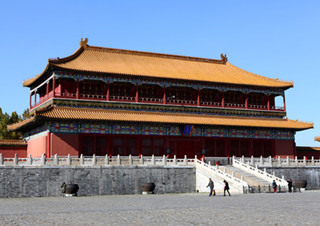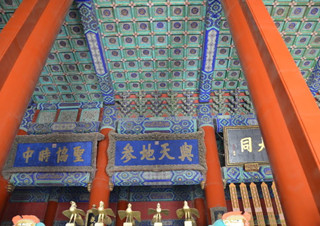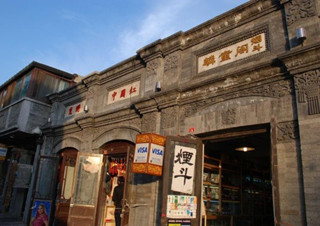- 86-15907880780
- contact@youngchinatravel.com
To know and understand the citybetter, we have to look back briefly at its history,  to see how it was trans- formed from a pre-historic village to a thriving metropolis, how its name was' changed several times by different emperors and its boundaries were altered under their rules. Most fascinating of all is irs role as the capital of many dynasties.
to see how it was trans- formed from a pre-historic village to a thriving metropolis, how its name was' changed several times by different emperors and its boundaries were altered under their rules. Most fascinating of all is irs role as the capital of many dynasties.
According to research, the area around modern Beijing was a gulf two or three million years ago, formed by the Taihang Mountains to the west and the Yanshan Mountains to the norrh. Mud and silt were washed down from the mountains by rains and melting snow and accumulated in the gulf, whch gradually became an alluvial plain, now called the Beijing sub-plain
Wirh the mountains to the norrh and west offering protection from strong northern winds, wet air blown from the sea to the east and a vast plain stretching out to the south, this sub-plain bhecame suitable environment for man to sertle in. Of course, as everybudy knows, Peking Man was the earliest inhabtant in the area and lived in caves southwest of today's Beijing city, about 500,000 years ago.
The new discovery in December 1996 at the southern entrance of Wangfujing Street (the busiest market street in Bei- jing) during a construction there shows that Peking Man had come to the plain from the mountain caves at Zhoukoud- an about 20,000 years ago at the late period of the Old Stone Age.
In ahout 2,000 B.C., some small set- tlements began to appear in southwest- ern Beijing at the place which is today called Guang'anmen ( 广 安 门, Gate of Broad Peace) on the banks of the Yong- ding River ( 永 定 河 Eternal Stabie River).
Because of its easy access to the Yel- low River valley, northeast plain, Mon- golian Plateau and North China plain, it had become an important centre ol communications. Later production and commerce became more developed and a market town called Ji( 蓟 )or Jicheng (蓟城)appeared in the area. It was probably the earliest predecessor of Beijing.
In the llth century B.C., a northerr kingdom called Yan ( 燕 )became very powerful and estahlished its capital at ji which was also known as Yanjing ( 燕 京 )(Yanjing is also another name for Beijing today.) Ji served as the capi- tal of Yan for ahour eigbr or mne hundred years before Qin Shibuang (秦始皇')(the First Lmperor of the Qn Dynasty) conquered the other six states in northern and cenrral China in 221 B.C. The state of Yan then ceased to exist and Ji became an ordinary town, but still strategically and commercially important.
In later times down to the TangDynasty (618-907),Ji remained just as another northern town in no pusition to compare with Xianyang ( 咸阳 ) (present-day Xi'an 西 安 )which was the capital of the Qin Dynasty or Chang'an ( 长 安 )(also present-day Xi'an), capital of the Han, Sui and Tang dynasties. However, it was not a complete backwater. In 755, a rebellion against the Tang rule was started at this place when it was calied Youzhou ( 幽州 ) .The rebel troops finally fought their way to Chang'an and shook the foundation of the Tang empire. The two leaders of the rebellion, An Lushan and Shi Siming, actually established their state and crowned themselves the emperors of the Yan successively, though both were re- garded outlaws and viewed negatively in history. A stone stele erected by Shi Siming, which records the rebellon, 1s still well preserved in Fayuansi Temple ( 法 源 寺 )in Beijing.
Tbe Tang Dynasty was succeeded by tbe Song (960- 1279)in central and south China and by the Liao(916- 1125) in the north. A Mongolian tribe from West Liao River in north China calied Khtan ( 契 丹 )founded the Liao and captured Youzhou which became the se-condary capital of the Liao and was renamed Nanjing( 南 宗 ,Southern Capital). Histoncai reminders of the Liao can still be found in Beijing: the pagoda of the Tianningsi,Temple ( 天 宁 寺 ) ,a Liao-style building, and a stele in the Dayuesi Temple ( 大 党 寺 )in the Western Hills recording the building of a tower in the Liao style to house the Buddhist Triprtaka. The Khitans were driven out of th city by a Tungusic tmbe (Jurchen 女 真 )from northeast China which established the Kin Dynasty. Yanjing was made the capital of the Kin Dynasty and had jts name changed to Zhongdu (Central Capital 中都). The Kin ru- lers started extensive construction in the capital, and the city boundanes were enlarged to the east, south and west. A new grand impenal palace was built in the centre of the city, modelled on the palace in tbe Nortbern Song capital Bianliang( 汴梁 ,present-day Kaifeng). Only under the Kin did the city really take shape as an imperial capital, though its size was much smaller than in later dynasties, and its location was to the southwest of present-day Beijing.
The Mongols grew in strength very rapidly in the early 13th century,  Jnd their cavalry forces under Genghis Khan rode south, meeting with little resistance, down to Zhongdu where there was fierce fighting with rhe Kin troops, and the magnificent city was nearly burned down to the ground.
Jnd their cavalry forces under Genghis Khan rode south, meeting with little resistance, down to Zhongdu where there was fierce fighting with rhe Kin troops, and the magnificent city was nearly burned down to the ground.
Kublai Khan, grandwn ot Genghis Khan, came down to Zhongdu in 1260 in an attempt to extend his rule over the whole country from the city. He made ir his capital which was called Khanhaliq (Khan's Town) and known m Chinese as Dadu (人都Great Capital). The extensive reconstruction of the city was soon started. Since Daninggong (人宁宫 Palace of Great Tranquillity) was the only palace which had escaped destruction in the war, Kublai Khan used it as the centre of his new capital. The palace was in the northeast suburbs outside the Kin capital and roughly located on the site of today's Beihai Park.
The Yuan Dynasty was founded in 1271, and Dadu then for the first time became the national capital of a unified China. It remained a national capital under different names and in different dynasties with only minor interruptions up to the present day.
The rebuiiding of the capital was on a grand scale. Palaces were built around the lakes (today's Zhonghai and Beihai) forming an Imperial City. The palaces on the eastern bank of the lakes, where the Yuan emperor administered his state affairs and lived, were called Danei (人内 Great Within), the predecessor of the Forbidden City in the Ming and Qing dynasties.
Now Dadu was on a much larger scale, walled on four sides and with two gates in its northern wall and three gates in each of the other three walls. Outside rhe high walls were surrounded by moats, which protected the city fiom attacks. Broad and straight roads ran through the city connecting opposite wall gates, intersected by Jiutongs (small alleys).
One disadvantage of Dadu was the lack of a good water supply since there was no river running through the city. Kublai Khan ordered a famous hydraulic engineer Guo Shoujing ( 郭守敬 ) to solve the problem. Guo brought waters ^ from Yuquanshan (玉泉山Jade Spring O Hill) in the Western Hills to a lake in the city called Jishuitan (积水潭 Water Accumulating Pool) to improve the water supply. He then cut the Tonghui Canal, linking Tongzhou (通州,today's Tongxian) with Jishuitan. The other end of the Tonghui Canal connected to the Grand Canal which was built in rhe 7th century in the Sui Dynasty and rebuilt in the 13th century under the Yuan, so that canal barges from the south could directly entet the city.
The prosperous city of Dadu attracted many merchants and monks to come from other parts of the country as well as from abroad. Frequent contacts with foreign countries had promoted the eco-nomic and cultural development of the Yuan empire. The Yuan rulers were probably much more open to the outside than the rulers in the Ming and Qing dynasties. A few foreigners were even appointed officials in the Yuan imperial court. The famous Italian traveller Marco Polo came to China with his father and uncle in November 1271 and re-ceived special favour and was appointed a consultant official of the Yuan empire by Kublai Khan. He described in his Travels: "On the banks of a great river in the province of Cathay there stood an ancient city of great size and splendour which was named Khanbaliq, or the Khan's city." It is interesting to read his detailed description of the great city and the life at that time and cry to find traces of it in present-day Beijing,
After the death of Kublai Khan, the Mongol empire began to decline and was overthrown in the mid-14th century by a successful rebellion led by Zhu Yuanzhang (朱元璋) who founded the Ming Dynasty in 1368, He made Nanjing (南京 ) as its capital. His general Xu Da ( 徐达) drove the last Yuan emperor out of Dadu on his northern expedition, and then the city was renamed Beiping (北京Northern Peace). Xu Da reduced the size of the city by moving the northern wall south to its present position. Enthusiasts of history may like to go to the north of Desheng-men whete an earthen mound, known as the Earthen Wall, and a stele on it still remains.
Zhu Di ( 朱 棣 ) ,the son of Zhu Yuanzhang, became the third emperor of the Ming in 1403 adopting the reign title Yongle (永乐) . He officially moved his capital to Beiping in 1421. Beiping was then changed into Beijing (北京 Northern Capital), a name it has retained up to the present day.
Emperor Yongle rebuilt Beijing on a grand scale, modelled on Dadu, while drawing different architectural styles from other old capitals, especially Nanjing. The new achievements included the Forbidden City, palaces and halls, altars, temples, and the Drum and Bell towers. The city walls also underwent changes; the northern wall was taken further south and the southern wall was moved south from the Yuan boundary along present-day Chang'an Avenue ( 长 安 街 )to the line marked by today's Qianmen ( 前 门 Front Gate); the wall was much longer, more than twenty kilometres, enclosing the city and nine rowers were added to rhe wall. During the reign of Emperor Jiajing (嘉端 reign 1522- 1566), another city wall was added to enclose the southern suburbs. Beijing therefore had two towns: a square inner city and an oblong outer city to the south. This structure remained unchanged throughout the rest of the Ming Dynasty, the whole Qing Dynasty and the republic until 1949.
In 1644, a peasant rebellion army led by Li Zicheng ( 李 自 成 ) overran Beijing and overthrew the Ming e pire. The Manchu forces from north- east China had long had ambitions on central China, but were held back by the Great Wall. Taking advantage of the turmoil in central China and helped by a Ming general, the Manchu troops passed through the Great Wall and de- feated the peasant rebels. They finally oxcupied Beijing and the city became the capital of the Qing Dynasty (1644-1911).
During the Qing period, improvements were made to the Forbidden City, which the Qing rulers continued to use as their imperial palare, and to Beihai, in which the White Dagoba was built. However, the Qing rulers made no at- tempt tu change the face of the city, but used large amounts of money and man- power to build a vast complex of imper- ial gardens and palaces on the north- western outskirts of Beijing. The grea- test achievements were made during the reign of Emperors Kangxi (r. 1662-1722) and Qianlong (t. 1736-1795), such as Yuanmingyuan ( EIBJO Garden of Perfection and Brightness or Old Summer Palace) and Yiheyuan ( KlftS Garden of Nurtured Harmony or the Summer Palace).
In 1860, the Anglo-French joint force invaded Beijing and burned Yuanmingyuan to the ground. In 1900. the Eight-powet Allied Forces invaded Beijing again.
In the late Qing petiod, the Qing rule became very weak and  corrupted. Poverty, bankruptcy and famine forced the desperate peasants to rise up in re-sistance. New democratic ideas were also introduced into China, especially from Japan. A struggle between reformists and conservatives began. The reformists, led by Kang Youwei (康有为), gained support from Emperor Guangxu ( 光绪), but were »uppi«sed by the die-hards, led by Empress Dowager Cixi. Many reformists were either executed or fled, and even Emperor Guangxu was for awhile under house-arrest in the Summer Palace and Beihai Park.
corrupted. Poverty, bankruptcy and famine forced the desperate peasants to rise up in re-sistance. New democratic ideas were also introduced into China, especially from Japan. A struggle between reformists and conservatives began. The reformists, led by Kang Youwei (康有为), gained support from Emperor Guangxu ( 光绪), but were »uppi«sed by the die-hards, led by Empress Dowager Cixi. Many reformists were either executed or fled, and even Emperor Guangxu was for awhile under house-arrest in the Summer Palace and Beihai Park.
After the 1911 revolurion led by Dr. Sun Yat-sen ( 孙中山 ), the Qing empire was overthrown and the Republic of China was founded. Beijing was again changed back to Beiping since the Republic had chosen its capita in Nanjing. ("Jing" means capital in Chinese. It was considered improper to have more than one "jing" in a country, so that the city's name was changed to and back between "Beijing" and "Beiping" several times in history.) This was followed hy a pettod of national wars between warlords, and Beiping was occupied by the Northern Warlords. New democratic activities started up in Beiping, such as the May 4th Movement of 1919, and the ancient capital saw many political power struggles.
As a result of the new democratic movement which is tegarded as a turning point in Chinese history, the worker's movement grew rapidly and a new party was born—the Communist Party of China. One of its founders was Mao Zedong who worked for a while as a librarian in Beijing University. The Communist Party and the Kuomintang joined forces in struggles against the warlords.
Japan had had long ambitions of oc-cupying China. It first occupied the Norrheast in 1931, and established a puppet government with the last Qing emperor Puyi as the head ol the so-culled "State of Manchuria". The Ku.i-mintang, then led by Chiang Kai-shek, refused to fight againsr rhe Japanese but tried to eliminate the Communists. The Communists were forced to take the world-famous "Long March" ro arrive at the Northwest to have their new base to tight rhe Japanese.
The Japanese started an all-round invasion of China bv attacking Wanping town at the Marco Polo Bridge near Beijing. Beijing was soon conquered by the Japanese troops.. Under the pressure from the populate, the Kuomintang finally agreed to fight against the Japanese side by side with the Communists, after the "Xi'an lmidcrsi" in which two Kuomintang generals house-arrested Chiang Kai-shek.
Following the surrender of Japan in 1945, a civil war broke out between the Communists and the Kuomintang, and ended with the defeat of the latter. The People's Republic of China was announced to be founded in 1949, and Beijing (its name having hern changed back again) became the capital city onte more.
During the war period, the city fot-tunately escaped any great destruction. M.iny sites and objects of historical value have been preserved, with the exception of (he Qing tombs which were robbed by warlords.
After 1949, reconstruction of the city began on a large scale. First, the place in front of the Tian'anmen (天安门) was cleared to become a large square, and Chang'an Avenue was broadened to link the two gates in rhe east and west walls.
The archways which originally stood at Xidan (西单), Dongdan(东单), Xisi(西四) and Dongsi (东四) were pulled down for the purpose. Another cause for regret is that the former Imperial City walls were levelled to provide the route for the Second Ring Road and an underground tail way underneath. Only a few sections cf the walls and wall towers were kept for tourist purposes, such as rhe sections at Xibianmen (西便门) and Chongwenmen (崇文门) and rhe towers of Qianmen (前门) and Deshengmen (德胜门). Another section of the old city wall is to be restored in 1997 near the Beijinu Railway Station. Those who are interested in can find mote information about the city walls in books on old Beijing or pay a visit to rhe Old Beijing Panorama Park.
Now, Beijing has developed into a modern city. The economic relorm began in late 1970s has given the old city a new look. It has witnessed a massive building boom to meet rhe needs of a modern, international metropolis for offices, hotels and residential property. More roads have been built—there are three ring roads, and rhe fourth and fifth ring roads are under plan for construction soon. Highways link Beijing with its suburban uiunty towns, and expressways extend to Tangu ( 塘沽), the sea port in the east, and to Shijiaihuang (石家庄) in the south. A new railway station has just been completed and a new airport is under construction to provide better facilities for visitors. Beijing is looking forward to the 21st centuty.